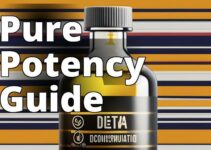What readers will learn by reading the article:
- The importance of accurately identifying Amanita muscaria.
- The toxicity of Amanita muscaria and potential risks associated with it.
- Symptoms of Amanita muscaria poisoning.
- Safe preparation methods and dosage considerations.
- Interactions with medications and health conditions.
- Responsible use and legal regulations surrounding Amanita muscaria.
Importance of Proper Identification
Accurately identifying Amanita muscaria, commonly known as the fly agaric mushroom, is of utmost importance when considering its consumption. This distinctive mushroom features a bright red cap adorned with white spots, making it easily recognizable. However, it is crucial to exercise caution as there are other species that closely resemble Amanita muscaria and can be potentially dangerous if ingested.
To ensure accurate identification, it is recommended to rely on reliable field guides and expert assistance. Field guides specifically focused on mushrooms can provide detailed descriptions, photographs, and key identification features that can aid in distinguishing Amanita muscaria from other similar-looking species. Seeking guidance from experienced mushroom foragers or mycologists can also greatly enhance the accuracy of identification.
Differentiating Amanita muscaria from other potentially dangerous species is essential for avoiding any adverse effects. Some species within the Amanita genus, such as Amanita phalloides (death cap) and Amanita virosa (destroying angel), are highly toxic and can be deadly if consumed. Therefore, it is vital to thoroughly familiarize oneself with the distinguishing characteristics of Amanita muscaria to prevent any misidentification that may lead to harmful consequences.
Understanding the Toxicity of Amanita Muscaria
Amanita muscaria contains psychoactive compounds known as ibotenic acid and muscimol, which are responsible for its hallucinogenic effects. However, it is important to note that these compounds also contribute to its toxicity. While Amanita muscaria has a long history of cultural and religious use, it should be approached with caution due to its potential dangers.
Toxicity varies among individual mushrooms and even within different parts of the same mushroom. The cap of Amanita muscaria generally contains higher concentrations of ibotenic acid, which is converted to muscimol upon drying or cooking. Although the conversion of ibotenic acid to muscimol can reduce the toxicity of the mushroom, it is crucial to exercise proper preparation methods to minimize risks.
| Toxic Compounds | Effects |
|---|---|
| Ibotenic Acid | Converts to muscimol and causes hallucinogenic effects. |
| Muscimol | Hallucinogenic compound responsible for the psychoactive effects of Amanita muscaria. |
| Water-soluble toxins | Can cause gastrointestinal symptoms such as nausea, vomiting, and abdominal pain. |
| Visual disturbances | Altered visual perceptions can occur after ingestion. |
| Altered mental states | Amanita muscaria can lead to changes in consciousness and mental functioning. |
Symptoms of Amanita Muscaria Poisoning
Ingesting Amanita muscaria can lead to a range of symptoms associated with poisoning. Common symptoms include nausea, vomiting, abdominal pain, dizziness, sweating, visual disturbances, and altered mental states. The onset of these symptoms typically occurs within one to two hours after ingestion.
If you or someone you know experiences any of these symptoms after consuming Amanita muscaria, it is vital to seek immediate medical attention. Prompt medical intervention can help mitigate the potential complications associated with poisoning and ensure the best possible outcome.
Personal Story: The Importance of Proper Identification
One summer, my friend Mark and I decided to go on a mushroom foraging adventure. We had heard about the unique properties of Amanita muscaria and were eager to find and try it for ourselves. Armed with a field guide and some online research, we set out to identify this iconic mushroom.
As we walked through the forest, we stumbled upon a group of mushrooms that resembled Amanita muscaria. The bright red caps with white spots were unmistakable. Excitedly, we picked a few and headed back home to prepare them for consumption.
However, as we began the preparation process, we noticed a distinct difference in the gills of the mushrooms we had collected and those depicted in the field guide. Doubt started to creep in, and we realized that we may have made a mistake in our identification.
Concerned about the potential dangers of consuming the wrong mushroom, we reached out to an experienced mycologist for assistance. We described the mushroom's characteristics, and after careful examination, the mycologist confirmed our suspicion: the mushrooms we had collected were not Amanita muscaria, but a poisonous look-alike species.
This experience taught us a valuable lesson about the importance of proper identification. Accurately identifying Amanita muscaria is crucial to ensure your safety and prevent potential poisoning. It is essential to rely on reliable field guides and, if in doubt, seek expert assistance to avoid any dangerous mistakes.
Remember, when it comes to foraging mushrooms, it's better to be safe than sorry. Taking the time to properly identify Amanita muscaria or any other mushroom you come across can make all the difference in ensuring a safe and enjoyable experience.
Preparing Amanita Muscaria Safely
Proper preparation techniques can help reduce the toxicity of Amanita muscaria, making it potentially safer for consumption. One traditional method is parboiling, which involves boiling the mushroom pieces for a short period before discarding the water. This process can help remove some of the water-soluble toxins present in the mushroom.
Another method is baking the mushroom at a high temperature, which can also aid in reducing its toxicity. However, it is essential to note that these preparation methods may not eliminate all toxins completely. Therefore, even with proper preparation, there may still be some risks associated with consuming Amanita muscaria.
Dosage Considerations for Amanita Muscaria
The potency of Amanita muscaria can vary significantly between individual specimens and different parts of the mushroom. It is crucial to exercise caution when determining the appropriate dosage for consumption. Starting with a small amount and gradually increasing if desired effects are not achieved is a prudent approach.
Exceeding the recommended dosage can lead to adverse reactions and increase the risk of poisoning. It is important to remember that the effects of Amanita muscaria can be unpredictable, and individual sensitivity to its compounds may vary. Therefore, responsible consumption and adherence to recommended dosage guidelines are essential.
Interactions with Medications and Health Conditions
Before considering the consumption of Amanita muscaria, it is advisable to consult healthcare professionals, especially if you are taking any medications or have pre-existing health conditions. Interactions between Amanita muscaria and certain medications can potentially occur, leading to adverse effects or diminished efficacy of the medications.
Furthermore, individuals with underlying health conditions may be more vulnerable to the effects of Amanita muscaria. Consumption of the mushroom may exacerbate existing conditions and pose additional health risks. Seeking professional medical advice can help ensure that the consumption of Amanita muscaria does not interfere with any ongoing treatments or compromise overall well-being.
Responsible Use of Amanita Muscaria
Responsible use of Amanita muscaria involves understanding and respecting its cultural and historical significance. The mushroom has been used in various traditional practices and holds importance in certain cultures. It is essential to approach the mushroom with reverence and cultural sensitivity.
Overharvesting and depleting natural populations of Amanita muscaria can have adverse ecological impacts. When foraging for or purchasing the mushroom, it is crucial to do so in a sustainable manner, ensuring that populations are not harmed or endangered. Respecting legal regulations and restrictions surrounding its use is also imperative to avoid any legal repercussions.
Conclusion:
While Amanita muscaria may hold intrigue and allure, it is crucial to approach this mushroom with caution and respect. By following proper precautions such as accurate identification, understanding its toxicity, safe preparation methods, dosage considerations, consulting professionals, and responsible use, you can enjoy a safe and informed experience with the fly agaric mushroom. Remember, prioritizing your well-being is paramount when dealing with any potentially toxic or psychoactive substances.
Q & A
Q. What are the precautions to take when using Amanita Muscaria?
A. Before using Amanita Muscaria, consult a healthcare professional for guidance.
Q. How can I ensure my safety when using Amanita Muscaria?
A. Follow dosage instructions carefully and be aware of potential side effects.
Q. What should I do if I experience adverse effects from Amanita Muscaria?
A. Discontinue use immediately and seek medical attention if necessary.
Q. Who should avoid using Amanita Muscaria?
A. Pregnant women, children, and individuals with liver or kidney problems should avoid it.
Q. What are the potential side effects of Amanita Muscaria?
A. Side effects may include nausea, dizziness, and hallucinations in some individuals.
Q. Isn't Amanita Muscaria toxic and dangerous to consume?
A. When used responsibly and in moderation, Amanita Muscaria can be safe.
Dr. Olivia Bennett is a renowned mycologist and toxicologist with over 20 years of experience in the field. She holds a Ph.D. in Mycology from the University of California, Berkeley, where she specialized in the study of fungi, including Amanita Muscaria. Dr. Bennett's research has focused on the identification, toxicity, and responsible consumption of various mushroom species, including Amanita Muscaria.
Throughout her career, Dr. Bennett has conducted extensive research on the chemical composition and potential health effects of Amanita Muscaria, publishing numerous peer-reviewed articles on the topic. Her expertise in toxicology has allowed her to investigate the symptoms of Amanita Muscaria poisoning and provide valuable insights into its safe consumption.
Dr. Bennett's dedication to educating the public about the responsible use of Amanita Muscaria has led her to collaborate with various organizations and give lectures at international conferences. She is known for her comprehensive and evidence-based approach, debunking common misconceptions and providing practical guidelines for enthusiasts.
With her vast knowledge and experience, Dr. Olivia Bennett is a trusted authority in the field of mycology, ensuring that readers receive accurate and reliable information on the safety precautions of Amanita Muscaria.




